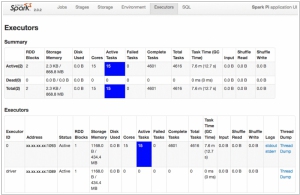Apache Cassandra vs Apache Spark
March 18, 2025 | Author: Michael Stromann
12★
Apache Cassandra is an open source distributed database management system designed to handle large amounts of data across many commodity servers, providing high availability with no single point of failure. Cassandra offers robust support for clusters spanning multiple datacenters, with asynchronous masterless replication allowing low latency operations for all clients.
17★
Apache Spark is a fast and general engine for large-scale data processing. Run programs up to 100x faster than Hadoop MapReduce in memory, or 10x faster on disk. Write applications quickly in Java, Scala or Python. Combine SQL, streaming, and complex analytics.
See also:
Top 10 Big Data platforms
Top 10 Big Data platforms
Apache Cassandra and Apache Spark are both open-source software projects, which is a bit like saying that both dolphins and spaceships are excellent ways to travel—technically true, but missing the finer points. They exist to handle absurdly large amounts of data, preferably without collapsing into a singularity of unreadable error logs. They are distributed, scalable and very good at making sure that when you ask for data, you get it quickly—though not necessarily in the way you expected. Also, for reasons best left to history, they work quite well together, like an odd couple forced to share a flat and somehow making it work.
Cassandra, named after a mythological figure who knew the future but was ignored (a fitting name for a database, really), was born at Facebook in 2008 and has since spread across the globe like a particularly persistent species of weed. It is a database, which means it hoards data in a columnar format with an enthusiasm usually reserved for dragons and their gold. It is designed to never go down, no matter how badly you treat it and offers something called "tunable consistency," which is a fancy way of saying, "You decide how much of a liar your database should be." It thrives in environments where data arrives at breakneck speed and needs to be retrieved at similarly unreasonable rates, such as finance, social media and any organization with an unhealthy obsession with tracking things.
Spark, on the other hand, emerged from UC Berkeley’s AMPLab in 2014, because someone there decided that Hadoop wasn’t quite painful enough and needed improvement. Unlike Cassandra, it does not store data—it simply processes it, like a hyperactive librarian who refuses to keep books but insists on reading them all at once. It excels at crunching vast amounts of information, whether in batch processing, streaming or machine learning, which makes it the sort of thing that governments, researchers and companies with more money than sense adore. It operates on a system of Resilient Distributed Datasets (RDDs), which are not, in fact, resilient to everything and ensures that if you run the same query twice, you will get the same answer, which is more than can be said for most politicians.
See also: Top 10 Big Data platforms
Cassandra, named after a mythological figure who knew the future but was ignored (a fitting name for a database, really), was born at Facebook in 2008 and has since spread across the globe like a particularly persistent species of weed. It is a database, which means it hoards data in a columnar format with an enthusiasm usually reserved for dragons and their gold. It is designed to never go down, no matter how badly you treat it and offers something called "tunable consistency," which is a fancy way of saying, "You decide how much of a liar your database should be." It thrives in environments where data arrives at breakneck speed and needs to be retrieved at similarly unreasonable rates, such as finance, social media and any organization with an unhealthy obsession with tracking things.
Spark, on the other hand, emerged from UC Berkeley’s AMPLab in 2014, because someone there decided that Hadoop wasn’t quite painful enough and needed improvement. Unlike Cassandra, it does not store data—it simply processes it, like a hyperactive librarian who refuses to keep books but insists on reading them all at once. It excels at crunching vast amounts of information, whether in batch processing, streaming or machine learning, which makes it the sort of thing that governments, researchers and companies with more money than sense adore. It operates on a system of Resilient Distributed Datasets (RDDs), which are not, in fact, resilient to everything and ensures that if you run the same query twice, you will get the same answer, which is more than can be said for most politicians.
See also: Top 10 Big Data platforms





